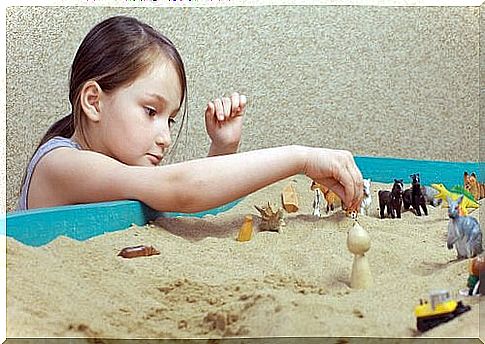The Sandbox Technique

We often go to a psychologist with an idea of what is going on inside us or with an identified cause of our discomfort. Many times, however, we cannot see or delimit the problem, and at this point the specialist must use several techniques to be able to separate the important information. Among them we have the sandbox technique, a method often applied, especially in child psychology, since children, due to their level of development, usually have many difficulties in expressing their feelings.
The sandbox technique, in its original name sandplay or sandplay in English, was devised by Swiss psychotherapist Dora M. Kalff. It was based on the analytical psychology of Carl Gustav Jung and the work of child psychiatrist Margarita Lowenfeld. It is mainly used to access information that not even the patient has consciously noticed or noticed.
What does the sandbox technique consist of?
To access these unconscious contents, we use a box with a blue background – it can be made of wood or plastic – filled with sand in which the patient, in silence, puts some different pictures. They represent elements or characters, real or imaginary, that the patient must silently place based on their personal preferences. Among these figures we can find people, animals and plants, constructions, means of transport, natural elements such as wood or stone, fantastic elements, movie characters, accessories… an infinity of options.

During the process, the therapist should limit himself to offering some auxiliary help, leaving the interpretation of what is happening until after listening to what the patient or client will say. On the other hand, it is also common for the psychologist to take a photo of the scene after it is finished, for its later interpretation outside the context of the consultation.
The results are very varied and there are thousands of possible interpretations for a sandbox. For example, if we find characters alone in the box, this can denote loneliness or a feeling of abandonment on the part of the patient. If, on the other hand, violence predominates in the scene, it can mean a certain feeling of desolation.
With which patients should I or can I use this technique?
Despite being used mainly in child psychology, the sandbox technique can be applied to patients of all ages. It is very helpful when we use this type of technique with patients who have difficulty talking about their emotions or even getting in touch with them. This technique is more precisely related to patients who have already suffered, for example, some type of trauma such as abuse, maltreatment… as this type of event usually generates repressed emotions. It is also very useful to use it with people who are experiencing conflicting issues or have emotional or behavioral disorders.
Children are still making their debut on the stage of emotional life. They are in the full development of their complex emotions, and often are not able to express what is happening or what they are feeling. That’s why they are the most common type of patient in the clinic. This technique is also used in school contexts to assess disorders related to language, self-esteem, interpersonal relationships, bullying or family problems.
What is the use of the sandbox technique?
The sandbox brings with it an important element of our children’s mental development: playful games. This creative sand game explores our ancient archetypal patterns that are part of every patient. The very action of playing in and with sand, visualization, personal choice, and the way the miniatures are placed in the sand activate this inner archetypal dimension.

Through the photographs that the therapist takes of the final result of the sandbox, it is possible to analyze various mental patterns from the patient’s unconscious. It is a very interesting technique because it accesses the patient’s interior from another plane than the linguistic one, which is more commonly used. In many cases, the patient is not even able to verbalize what is happening, especially if we are talking about children. Thus, given the impossibility of verbalization, the psychologist can have a sample of the problem through playful play.
All of these techniques are extremely useful as they create a stress-free space in the consultation in which the patient feels comfortable. Furthermore, the creative game helps to release tension and creates a place of respect and freedom in the consultation for the patient or client to express themselves freely.









